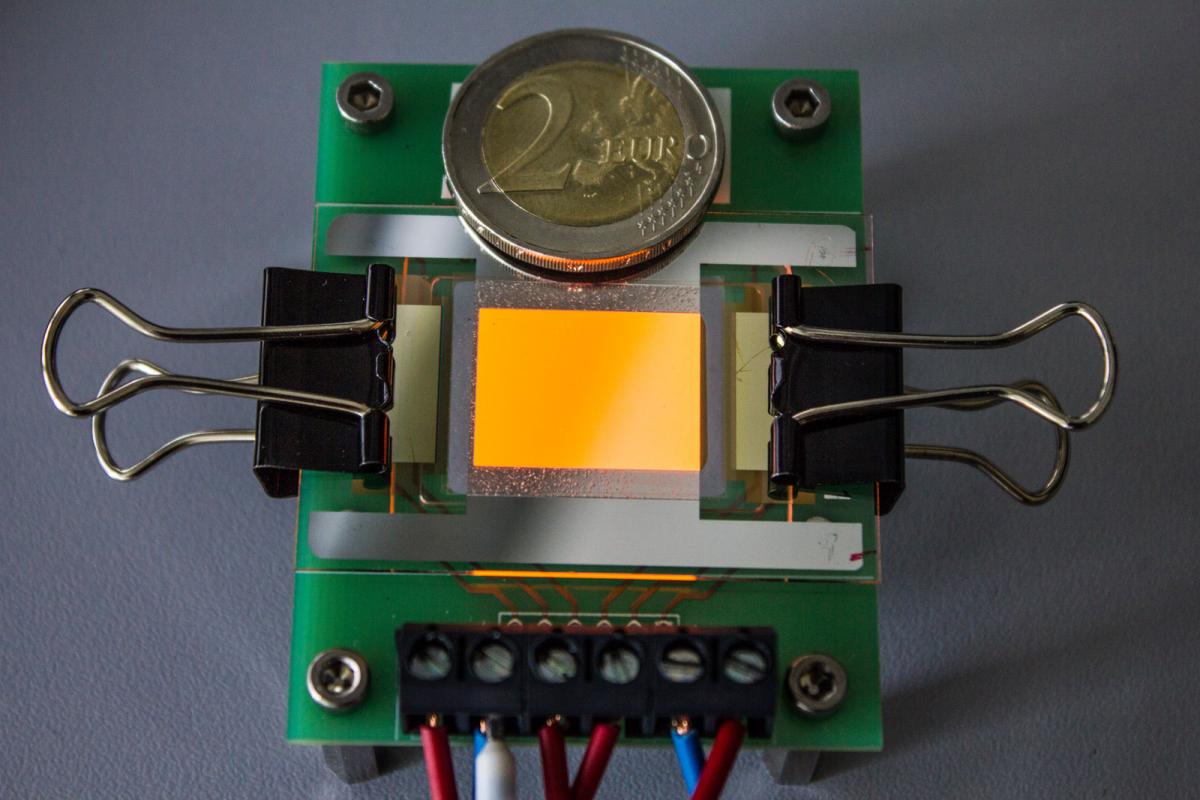Fraunhofer scientists have succeeded for the first time in producing OLED electrodes from graphene. The electrodes are transparent, flexible, and conductive – making them ideal for touch screens, wearables and photovoltaic applications.

Orange luminous OLED on a graphene electrode. The €2 coin serves as a comparison of sizes. Credit: Fraunhofer FEP
The new production method was developed and optimised as part of an EU-funded project, called ‘Gladiator’ (Graphene Layers: Production, Characterisation and Integration), which included partners from industry and research.
Graphene is considered a new miracle material because it is light and transparent but extremely hard and has more tensile strength than steel. Moreover, it is flexible and extremely conductive for heat or electricity. The material is just 0.3nm thick and consists of a single layer of carbon atoms which are assembled in a honeycomb pattern.
Fraunhofer’s new process of producing of OLED electrodes 2 × 1cm2 in size takes place inside a vacuum. In a steel chamber, a wafer plate of high-purity copper is heated to about 800°C. The research team then supplies a mixture of methane and hydrogen and initiates a chemical reaction, whereby the methane dissolves in the copper and forms carbon atoms that spread on the surface. This process only takes a few minutes. After a cooling phase, a carrier polymer is placed on the graphene and the copper plate is etched away.
‘This was a real breakthrough in research and integration of extremely demanding materials,’ said Dr Beatrice Beyer project leader at the Fraunhofer Institute for Organic Electronics, Electron Beam and Plasma Technology FEP.
The Gladiator project was launched in November 2013 and concludes this year. For the remainder of the project, the Fraunhofer team will work on minimising impurities and defects that occur during the transfer of the wafer-thin graphene to another carrier material.
Due to their flexibility, graphene electrodes are ideal for touch screens because, unlike glass, the material does not shatter or break. Many other applications are also conceivable - for example, the transparent graphene could regulate light transmission in windows or serve as an electrode in polarisation filters. Graphene can also be used in photovoltaics, high-tech textiles and even in medicine.
‘The first products could already be launched in two to three years,’ said Beyer with confidence.
The Fraunhofer Institute’s industrial partners include Spanish company Graphenea, responsible for the production of the graphene electrodes; and British firm Aixtron, in charge of building the production CVD reactors.
Related stories
Driven by design: Although OLED displays are now available commercially, the technology has not been as prevalent in other markets. Jessica Rowbury looks at the potential for using OLEDs in other applications
Further information

